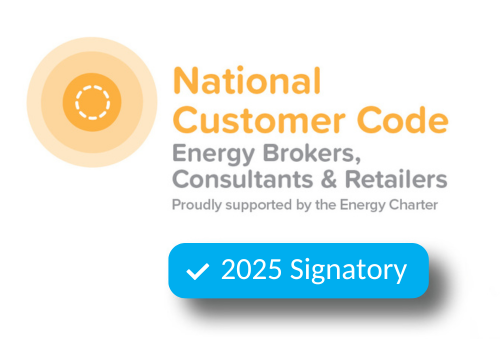
Australia is leading the way in renewable energy adoption, with solar energy significantly contributing to daytime electricity generation. However, this shift is reshaping the energy market, particularly in how electricity is priced. One of the most important consequences of this transition is the duck curve—a phenomenon that impacts both wholesale and retail energy pricing. Understanding this dynamic and how their energy load profile influences pricing is crucial for businesses.
This blog will help you understand how the renewable transition impacts the energy markets and, thus, retail offers for large business customers.

Let’s Get Technical
What is a Load Profile?
Load profile is a term used in energy to show how an energy user uses energy over a given period. The electricity spot markets now set a price for every 5-minute interval in a day, and smart meters also measure a business’s energy usage over 5-minute intervals.
Retailers are interested in the load profile shape which shows them how much energy they are buying during hours of the day throughout the weeks and months of the year.
The below graph shows the average hourly usage throughout the year of a cold storage and plastic manufacturing business. Both businesses use the same total volume of energy, however, they use that energy at different times of the day.

What is the Electricity Spot Market?
The electricity spot market is a platform where electricity is bought and sold in real time, with prices determined by supply and demand. Generators submit bids to supply electricity, and prices fluctuate based on factors like generation costs, grid demand, and availability of energy sources.
Australia’s National Electricity Market (NEM) works this way, setting prices every five minutes, thus allowing large users and energy retailers to buy power at spot prices instead of locking in fixed rates through long-term contracts. Spot market prices can be volatile, especially during periods of high demand or low supply.
What is the Duck Curve?
The duck curve is the mismatch between low daytime demand and high evening demand. During daylight hours, solar energy production surges (rooftop & grid solar), leading to an excess electricity supply which drives prices down. However, as the sun sets and solar generation diminishes, demand spikes—typically between 4 pm and 8 pm—as homes and businesses ramp up their consumption. This spike forces reliance on more expensive energy sources, such as gas, resulting in higher prices.
This pattern of low daytime prices followed by steep price increases in the evening forms the shape of a duck on a graph—hence the name.
(Our experts shared a detailed exploration of the Duck Curve here.)

The above graph shows the average spot price over 2015, whilst the below graph shows the average spot price in 2024. Focusing on the shape of each graph, you can see how the shape has changed significantly over time due to the extensive rollout of rooftop solar since 2015.

How Is This Impacting Retail Energy Pricing Offers
How a Business’s Load Profile Affects Rates
The load profile of a business—its pattern of energy use throughout the day—still plays a vital role for those on large market contracts. Before a retailer can provide a business with a retail offer, they will request meter data to see the load profile and determine how much power the business uses during specific intervals during the days, weeks, and months of the year.
Let’s take an example where Leading Edge requests pricing for two different businesses on the same day. Both of them use 500MWh of electricity per annum. However, one, a manufacturer, uses their power between 7 am-4 pm, and the other, a cold storage facility, uses theirs steadily over the entire day.
Below you will see an example where two different businesses use the same total volume of power but with different load profile shapes. As we lay the business load profile shapes over spot prices over the years (the duck curve shape), we see the following:
- The plastic manufacturer is using large volumes of energy when the spot price is low
- The cold storage uses steady volumes of power 24 hours a day.
- When spot prices are high, the cold storage business uses high volumes of power compared to the manufacturer.

The result is that the retailer will be buying more expensive power for the cold storage business and cheaper power for the manufacturer.
Put simply, this means the retailer will provide more attractive rates to the manufacturer.
Retailers Still Use Simplified Tariffs
Despite the discrepancy between daytime and nighttime spot prices, many energy retailers still offer simplified pricing structures, typically with just one peak rate and one off-peak rate. This approach bundles hours of varying costs—ranging from extremely low midday prices to very high evening prices—into a single rate that covers long periods, often from 7 am to 10 pm.
This means businesses are often charged an average rate for their entire day’s consumption. As a result, they don’t benefit from the low prices available during solar-rich hours, nor are they properly incentivized to reduce their energy usage during peak periods when costs are highest. This creates a significant disconnect between the true cost of energy and the signals businesses receive through their bills.
Businesses that use lots of power during the day and little during nighttime are presented with peak rates that are lower than off-peak rates.
Below is a snip of a recent tender we conducted, whereby you will see 2 retailer offers that present lower peak rates than they do for off-peak rates. This is due to the customer’s load profile shape in conjunction with the duck curve shape of our spot market,

Misaligned Price Signals
The simplified peak/off-peak pricing structure obscures the nuances of daily price fluctuations, sending the wrong signal to energy users. Businesses that could otherwise shift some of their energy consumption to low-cost periods (such as during midday solar production) are not rewarded for doing so. Conversely, companies consuming high amounts of energy during the expensive peak evening hours are not penalized appropriately, as the average rate smooths out the price spikes.
This lack of price granularity means businesses are not motivated to adjust their load profiles in line with market conditions. The misaligned signals ultimately stifle opportunities for businesses to optimize their energy usage, reduce costs, and support the broader transition to renewable energy.
Conclusion: The Need for More Granular Pricing
As Australia continues its renewable transition, businesses must understand the impact of the duck curve on retail energy pricing. Retailers still rely heavily on simplified peak/off-peak rates, which do not reflect the true variability in energy costs. This limits the ability of businesses to respond to price signals and optimize their operations accordingly.
Moving forward, more granular pricing structures that reflect real-time wholesale price fluctuations could empower businesses to better align their energy use with the market, reduce costs, and support the ongoing shift toward renewable energy. Until then, understanding the limitations of the current system and how load profiles influence rates is essential for businesses to make informed energy decisions.
—
Navigating Australia’s ever-changing and volatile energy market can be daunting and time-consuming for businesses. Fortunately, Leading Edge Energy is prepared to assist C&I and SME customers through the process of energy purchasing, providing insights and analysis based on their unique requirements.
Get in touch with our energy management consultants at 1300-852-770 or info@leadingedgeenergy.com.au for inquiries or, if you’re ready, you can Get Started Here.
We source, analyse, compare and rank commercial, industrial and multisite energy quotes. Obligation Free.
Chat with one of our experienced consultants today and get the insights your business needs to help manage the risks associated with volatile electricity and natural gas markets. Our energy procurement service is obligation-free and provides a time-saving way of securing lower energy rates from our panel of seventeen energy retailers.

Get advice from our Energy Management Consultants

Ewen Beard
Sales Manager
Get in Touch
Feel free to call or e-mail us. Or just fill in the form below and we’ll contact you for an obligation-free discussion.
Are you ready to save on business energy costs?
Get Started
Leading Edge Energy is proud to be a signatory of the National Customer Code for Energy Brokers, Consultants and Retailers.